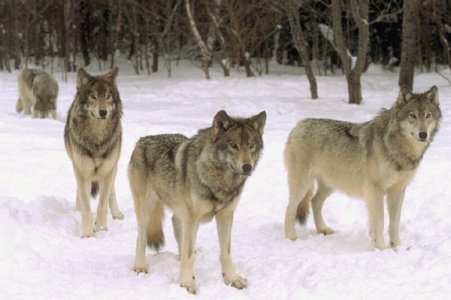

Click on picture
to hear wolf howl
Welcome. My name is Sybil, and as you can probably tell, I love wolves. They are such beautiful animals - wild and free.

The wolf is a highly social animal, generally living within the same pack for most or all its life. Wolf packs vary in size. Most packs are 6 to 10 wolves, but some have up to 30 members.
Howling is what holds the wolf pack together. They travel over large areas to find food, so they are often separated. Howling is the main call that they can hear over great distances. If a wolf is separated from the pack, he will begin howling to attract their attention and find his way back. The howl of a wolf is a very haunting sound.

Sometimes a member of a pack goes off alone. A wolf can travel as far as 500 miles in search of a mate. In early history, wolves were the most widely distributed mammals on earth. But now they are extinct in some places or threatened with extinction in much of their native habitat.
In the area where I live, southeastern Canada, there are many eastern timber wolves. Recently there has been some evidence found that wolves and coyotes have been inbreeding.
Wolves are predators and play a very important part in our
ecosystem. They are at the top of the food
chain. As predators, they serve to help keep the ecosystem in balance by hunting primarily on prey
that is weak, sick or elderly, leaving stronger and healthier animals to survive.
Other predators who compete with wolves would be cougar, coyote, bear and humans.
The wolf does not have an easy life looking for food. Almost every time they are hungry, wolveshave to find and kill their prey. They have to use their
senses of smell and hearing to help them. Therefore wolves look for animals they can kill easily, using as little energy as possible and taking liitle chance of being injured. The wolf's primary food
source is deer, elk and caribou. Wolves will also eat smaller animals like beaver, rabbit, mice and ground squirrel.
When hunting large game, the wolf pack separates out and surrounds its prey. Wolves usually bite
the shoulders and flanks. While some pack members attack the prey from the rear, other wolves
seize the prey by the nose.

Wolves do not have a great track record as hunters; they only are able to kill about one out of ten large animals that they track. They also have to be very careful when attacking the larger animals as the antlers and hooves can injure or kill them.
Under noraml conditions, wolves need about 2 1/2 pounds of food a day, but in order to reproduce, they need about 5 pounds. When food is abundant, they often eat 10 pounds. A well fed adult wolf can go for weeks without eating, but then will eat 18-20 pounds all at once, when the food is there. When deer are plentiful, they eat 15 or more dear a year.
Wolves are built for a feast or famine diet and can "wolf" down up to 20 pounds at one feeding. If
wolves do not finish what they have killed, the leftovers will feed the scavengers - fox, coyote and
raven.

Wolves must travel many miles in order to find suitable prey. Scientists have estimated that one
wolf needs ten square miles for a "home" territory. In the Arctic, wolves often follow their main
prey, caribou, as the caribou migrate, often thousands of miles.


MY DOGS
GRAND MANAN WEATHER
Please  me
me
if you would like to talk about wolves.
WOLF LINKS
WOLVES
BLUE WOLF
WILD WORLD OF WOLVES
WOLF ADOPTION
ADOPT A WOLF
MAINE WOLF COALITION
SACRED WOLF DREAMS
SONG OF THE WOLF
EASTERN TIMBER WOLF
WOLVES, WOLVES, AND MORE WOLVES
NB COYOTES MAY BE WOLF HYBRID
CANADIAN CENTRE FOR WOLF RESEARCH
Please sign my guestbook so
I'll know that you have visited
Sign My Guestbook

View My Guestbook

MY ALTERNATE GUESTBOOK
View My Guestbook

Sign My Guestbook

 This
This
Circle
of the Wolf
site is owned by;
Wanna join the Circle
of the Wolf?
[Prev]
[Next]
[Skip
Next]
[Random]
[Next
5]
[List Sites]
[Chat]


ATLANTIC CANADA WEBRING
This Atlantic
Canada Webring site is owned by Sybil
Want To Join The
Webring?
[Prev5] [Skip Prev] [Prev] [ Next]
[Skip Next]
[Random]
[Next 5]
[List Sites]







MY DOGS
GRAND MANAN WEATHER
Please
 me
meif you would like to talk about wolves.
WOLF LINKS
WOLVESBLUE WOLF
WILD WORLD OF WOLVES
WOLF ADOPTION
ADOPT A WOLF
MAINE WOLF COALITION
SACRED WOLF DREAMS
SONG OF THE WOLF
EASTERN TIMBER WOLF
WOLVES, WOLVES, AND MORE WOLVES
NB COYOTES MAY BE WOLF HYBRID
CANADIAN CENTRE FOR WOLF RESEARCH
Please sign my guestbook so
I'll know that you have visited
Sign My Guestbook

View My Guestbook
MY ALTERNATE GUESTBOOK
View My Guestbook

Sign My Guestbook

 This
This
Circle of the Wolf site is owned by; Wanna join the Circle of the Wolf? |
|---|
| [Prev] [Next] [Skip Next] [Random] [Next 5] [List Sites] [Chat] |
